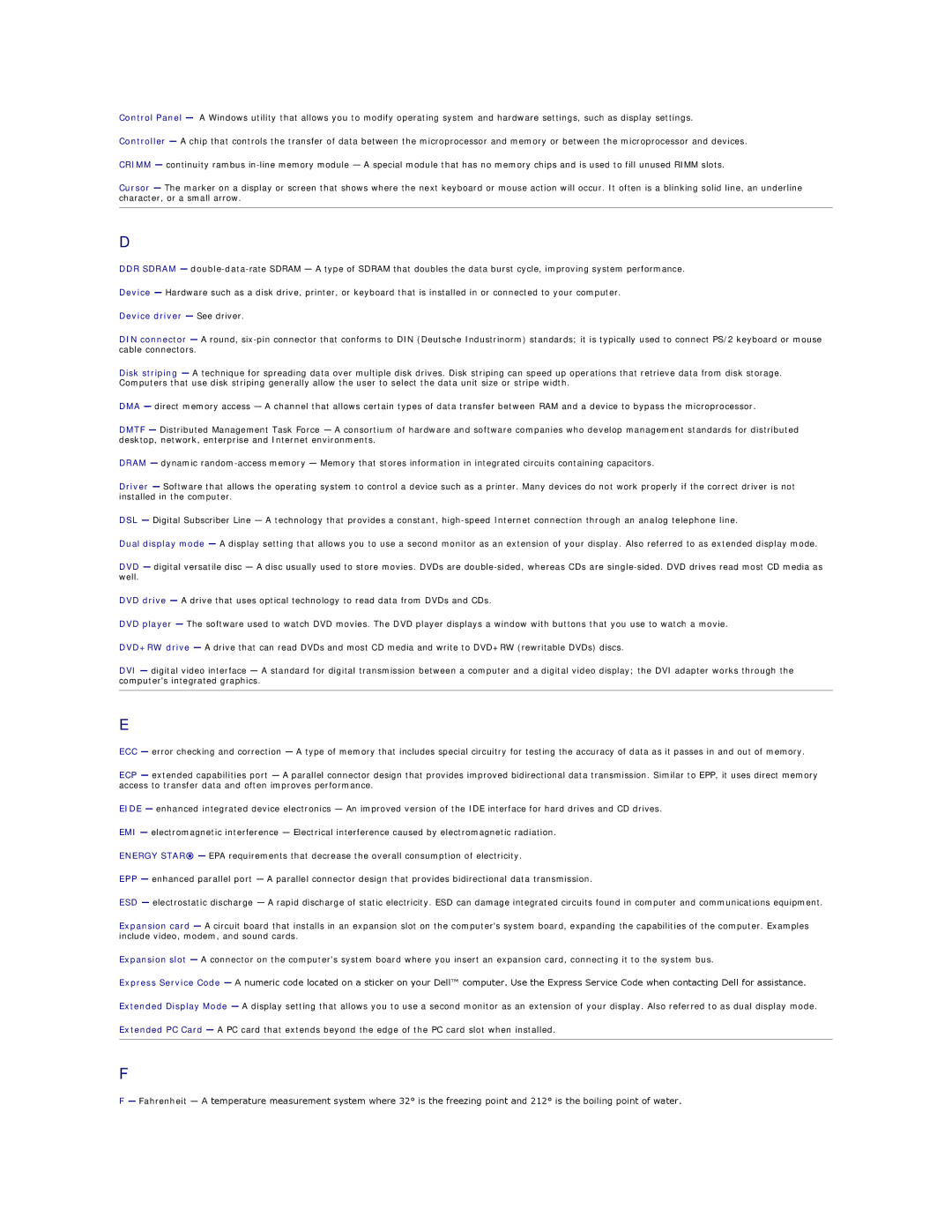
Control Panel — A Windows utility that allows you to modify operating system and hardware settings, such as display settings.
Controller — A chip that controls the transfer of data between the microprocessor and memory or between the microprocessor and devices.
CRIMM — continuity rambus
Cursor — The marker on a display or screen that shows where the next keyboard or mouse action will occur. It often is a blinking solid line, an underline character, or a small arrow.
D
DDR SDRAM —
Device — Hardware such as a disk drive, printer, or keyboard that is installed in or connected to your computer.
Device driver — See driver.
DIN connector — A round,
Disk striping — A technique for spreading data over multiple disk drives. Disk striping can speed up operations that retrieve data from disk storage. Computers that use disk striping generally allow the user to select the data unit size or stripe width.
DMA — direct memory access — A channel that allows certain types of data transfer between RAM and a device to bypass the microprocessor.
DMTF — Distributed Management Task Force — A consortium of hardware and software companies who develop management standards for distributed desktop, network, enterprise and Internet environments.
DRAM — dynamic
Driver — Software that allows the operating system to control a device such as a printer. Many devices do not work properly if the correct driver is not installed in the computer.
DSL — Digital Subscriber Line — A technology that provides a constant,
Dual display mode — A display setting that allows you to use a second monitor as an extension of your display. Also referred to as extended display mode.
DVD — digital versatile disc — A disc usually used to store movies. DVDs are
DVD drive — A drive that uses optical technology to read data from DVDs and CDs.
DVD player — The software used to watch DVD movies. The DVD player displays a window with buttons that you use to watch a movie.
DVD+RW drive — A drive that can read DVDs and most CD media and write to DVD+RW (rewritable DVDs) discs.
DVI — digital video interface — A standard for digital transmission between a computer and a digital video display; the DVI adapter works through the computer's integrated graphics.
E
ECC — error checking and correction — A type of memory that includes special circuitry for testing the accuracy of data as it passes in and out of memory.
ECP — extended capabilities port — A parallel connector design that provides improved bidirectional data transmission. Similar to EPP, it uses direct memory access to transfer data and often improves performance.
EIDE — enhanced integrated device electronics — An improved version of the IDE interface for hard drives and CD drives.
EMI — electromagnetic interference — Electrical interference caused by electromagnetic radiation.
ENERGY STAR® — EPA requirements that decrease the overall consumption of electricity.
EPP — enhanced parallel port — A parallel connector design that provides bidirectional data transmission.
ESD — electrostatic discharge — A rapid discharge of static electricity. ESD can damage integrated circuits found in computer and communications equipment.
Expansion card — A circuit board that installs in an expansion slot on the computer's system board, expanding the capabilities of the computer. Examples include video, modem, and sound cards.
Expansion slot — A connector on the computer's system board where you insert an expansion card, connecting it to the system bus.
Express Service Code — A numeric code located on a sticker on your Dell™ computer. Use the Express Service Code when contacting Dell for assistance.
Extended Display Mode — A display setting that allows you to use a second monitor as an extension of your display. Also referred to as dual display mode.
Extended PC Card — A PC card that extends beyond the edge of the PC card slot when installed.
F
F — Fahrenheit — A temperature measurement system where 32° is the freezing point and 212° is the boiling point of water.
